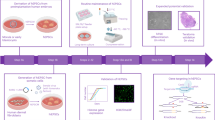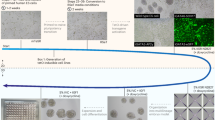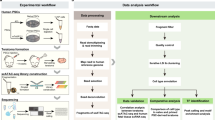Abstract
Parthenogenesis is one of the main, and most useful, methods to derive embryonic stem cells (ESCs), which may be an important source of histocompatible cells and tissues for cell therapy. Here we describe the derivation and characterization of two ESC lines (hPES-1 and hPES-2) from in vitro developed blastocysts following parthenogenetic activation of human oocytes. Typical ESC morphology was seen, and the expression of ESC markers was as expected for alkaline phosphatase, octamer-binding transcription factor 4, stage-specific embryonic antigen 3, stage-specific embryonic antigen 4, TRA-1-60, and TRA-1-81, and there was absence of expression of negative markers such as stage-specific embryonic antigen 1. Expression of genes specific for different embryonic germ layers was detected from the embryoid bodies (EBs) of both hESC lines, suggesting their differentiation potential in vitro. However, in vivo, only hPES-1 formed teratoma consisting of all three embryonic germ layers (hPES-2 did not). Interestingly, after continuous proliferation for more than 100 passages, hPES-1 cells still maintained a normal 46 XX karyotype; hPES-2 displayed abnormalities such as chromosome translocation after long term passages. Short Tandem Repeat (STR) results demonstrated that the hPES lines were genetic matches with the egg donors, and gene imprinting data confirmed the parthenogenetic origin of these ES cells. Genome-wide SNP analysis showed a pattern typical of parthenogenesis. All of these results demonstrated the feasibility to isolate and establish human parthenogenetic ESC lines, which provides an important tool for studying epigenetic effects in ESCs as well as for future therapeutic interventions in a clinical setting.
Similar content being viewed by others
Log in or create a free account to read this content
Gain free access to this article, as well as selected content from this journal and more on nature.com
or
References
Lindvall O, Kokaia Z . Stem cells for the treatment of neurological disorders. Nature 2006; 441:1094–1096.
Vats A, Bielby RC, Tolley NS, Nerem R, Polak JM . Stem cells. Lancet 2005; 366:592–602.
Thomson JA, Itskovitz–Eldor J, Shapiro S, et al. Embryonic stem cell lines derived from human blastocysts. Science 1998; 282:1145–1147.
Steinbrook R . Egg Donation and Human Embryonic Stem-Cell Research. N Engl J Med 2006; 354:324–326.
Kim K, Lerou P, Yabuuchi A . Histocompatible Embryonic Stem Cells by Parthenogenesis. Science 2006; 315:482–486.
Sánchez-Pernaute R, Studer L, Ferrari D, et al. Long-term survival of dopamine neurons derived from parthenogenetic primate embryonic stem cells (cyno-1) after transplantation. Stem Cells 2005; 23:914–922.
Kaufman MH, Robertson EJ, Handyside AH, Evans MJ . Establishment of pluripotential cell lines from haploid mouse embryos. J Embryol Exp Morphol 1983; 73:249–261.
Cibelli J, Grant K, Chapman K, et al. Parthenogenetic stem cells in nonhuman primates. Science 2002; 295:819.
Vrana K, Hipp J, Goss A, et al. Nonhuman primate parthenogenetic stem cells. Proc. Natl. Acad. Sci. U S A 2003; 100:11911–11916.
Revazova ES, Turovets NA, Kochetkova OD, et al. Patient-Specific Stem Cell Lines Derived from Human Parthenogenetic Blastocysts. Cloning and Stem Cells 2007; 9:1–9.
Kim K, Ng K, Rugg-Gunn P, et al. Recombination Signatures Distinguish Embryonic Stem Cells Derived by Parthenogenesis and Somatic Cell Nuclear Transfer. Cell Stem Cell 2007; 1:346–352.
Hernandez L, Kozlov S, Piras G, Stewart CL . Paternal and maternal genomes confer opposite effects on proliferation, cell-cycle length, senescence, and tumor formation. Proc Natl Acad Sci USA 2003; 100:13344–13349.
Mann JR, Stewart CL . Development to term of mouse androgenetic aggregation chimeras. Development 1991; 113:1325–1333.
Allen ND, Barton SC, Hilton K, Norris ML, Surani MA . A functional analysis of imprinting in parthenogenetic embryonic stem cells. Development 1994; 120:1473–1482.
Feinberg AP, Ohlsson R, Henikoff S . The epigenetic progenitor origin of human cancer. Nat Rev Genet 2006; 7:21–33.
Prawitt D, Enklaar T, Gartner-Rupprecht B, et al. Microdeletion and IGF2 loss of imprinting in a cascade causing Beckwith-Wiedemann syndrome with Wilms' tumor. Nat Genet 2005; 37:785–786.
Solter D, Knowles BB . Immunosurgery of mouse blastocyst. Proc Natl Acad Sci USA 1975; 72:5099–5102.
Li T, Zhou CQ, Mai QY, Zhuang GL . Establishment of human embryonic stem cell line from gamete donors. Chin Med J 2005; 118:116–122.
Klimanskaya I, Chung Y, Becker S, Lu SJ, Lanza R . Human embryonic stem cell lines derived from single blastomeres. Nature 2006; 444:481–485.
Parayre S, Falentin H, Madec MN, et al. Easy DNA extraction method and optimisation of PCR-Temporal Temperature Gel Electrophoresis to identify the predominant high and low GC-content bacteria from dairy products. J Microbiol Methods 2007; 69:431–441.
Loring JF, Rao MS . Establishing standards for the characterization of human embryonic stem cell lines. Stem Cells 2006; 24:145–150.
Brivanlou AH, Gage FH, Jaenisch R, Jessell T, Melton D, Rossant J . Setting standards for human embryonic stem cells. Science 2003; 300:913–916.
Jagerbauer EM, Fraser A, Herbst EW, Kothary R, Fundele R . Parthenogenetic stem cells in postnatal mouse chimeras. Development 1992; 116:95–102.
Hikichi T, Wakayama S, Mizutani E, et al. Differentiation potential of parthenogenetic embryonic stem cells is improved by nuclear transfer. Stem Cells 2007; 25:46–53.
Cattanach BM, Barr JA, Evans EP, et al. A candidate mouse model for Prader-Willi syndrome which shows an absence of Snrpn expression. Nat Genet 1992; 2:270–274.
Glenn CC, Porter KA, Jong MTC, Nicholls RD, Driscoll DJ . Functional imprinting and epigenetic modification of the human SNRPN gene. Hum Mol Genet 1993; 2:2001–2005.
Sakatani T, Kaneda A, Iacobuzio-Donahue CA, et al. Loss if imprinting of Igf2 Alters Intestinal Maturation and Tumorigenesis in Mice. Science 2005; 307:1976–1978.
Cassidy SB, Dykens E, Williams CA . Prader-Willi and Angelman syndromes: sister imprinted disorders. Am J Med Genet 2000; 97:136–146.
Matouk IJ, DeGroot N, Mezan S, et al. The H19 non-coding RNA is essential for human tumor growth. PLoS ONE 2007; 2:e845.doi: 10.1371/journal.pone.0000845.
Surani MA, Barton SC . Development of gynogenetic eggs in the mouse: Implications for parthnogenetic embryos. Science 1983; 222:1034–1036.
Allen ND, Logan K, Lally G, Drage DJ, Norris ML, Keverne EB . Distribution of parthenogenetic cells in the mouse brain and their influence on brain development and behavior. Proc Natl Acad Sci U S A. 1995; 92:10782–10786.
Kono T, Obata Y, Yoshimzu T, Nakahara T, Carroll J . Epigenetic modifications during oocyte growth correlates with extended parthenogenetic development in the mouse. Nat Genet 1996; 13:91–94.
Kono T, Sotomaru Y, Katsuzawa Y, Dandolo L . Mouse parthenogenetic embryos with monoallelic H19 expression can develop to day 17.5 of gestation. Dev Biol 2002; 243:294–300.
Kono T, Obata Y, Wu Q, et al. Birth of parthenogenetic mice that can develop to adulthood. Nature 2004; 428:860–864.
Hammond HA, Jin L, Zhong Y, Caskey CT, Chakraborty R . Evaluation of 13 short tandem repeat loci for use in personal identification applications. Am J Hum Genet 1994; 55:175–189.
Smith RN . Accurate size comparison of short tandem repeat alleles amplified by PCR. Biotechniques. 1995; 18:122–128.
Hwang WS, Ryu YJ, Park JH, et al. Evidence of a pluripotent human embryonic stem cell line derived from a cloned blastocyst. Science 2004; 303:1669–1674.
Stevens LC, Vamum DS, Eicher EM . Viable chimaeras produced from normal and parthenogenetic mouse embryos. Nature 1977; 269:515–517.
Fundele R, Norris ML, Barton SC, Reik W, Surani MA . Systematic elimination of parthenogenetic cells in mouse chimeras. Development 1989; 106:29–35.
Acknowledgements
This study was supported by the Hi-Tech Research and Development Program of China (863 Program 2006AA02A101).
Author information
Authors and Affiliations
Corresponding authors
Rights and permissions
About this article
Cite this article
Mai, Q., Yu, Y., Li, T. et al. Derivation of human embryonic stem cell lines from parthenogenetic blastocysts. Cell Res 17, 1008–1019 (2007). https://doi.org/10.1038/cr.2007.102
Received:
Revised:
Accepted:
Published:
Issue date:
DOI: https://doi.org/10.1038/cr.2007.102
Keywords
This article is cited by
-
Significant differences in efficiency between two commonly used ionophore solutions for assisted oocyte activation (AOA): a prospective comparison of ionomycin and A23187
Journal of Assisted Reproduction and Genetics (2023)
-
Generation of developmentally competent oocytes and fertile mice from parthenogenetic embryonic stem cells
Protein & Cell (2021)
-
Generation of human androgenetic induced pluripotent stem cells
Scientific Reports (2020)
-
Identification and propagation of haploid human pluripotent stem cells
Nature Protocols (2016)
-
Pluripotent stem cells in disease modelling and drug discovery
Nature Reviews Molecular Cell Biology (2016)



